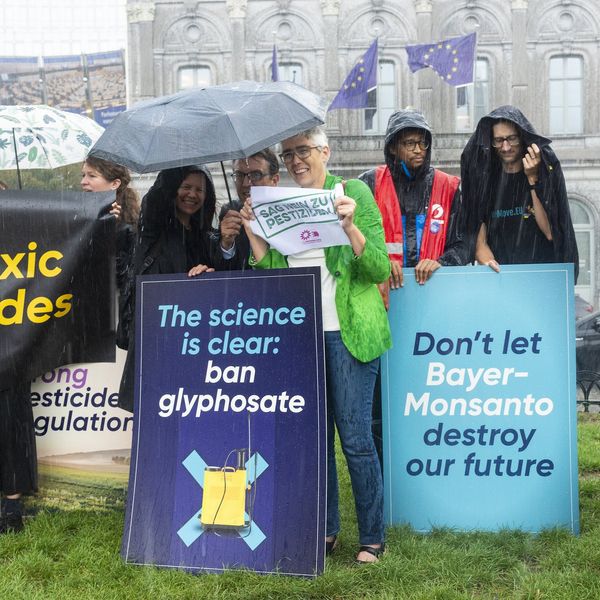Congresswoman Grace Meng (D-NY) was pregnant with her second child when she became concerned about the toxic chemicals that she and her kids — and nearly all of us — encounter every day.
It was 2009, and she had recently been elected to the New York State Legislature as it considered a bill prohibiting bisphenol-A (BPA) from infant and children's products sold in the state. She voted yes on the bill, which passed in 2010.
Now she wants to see similar action on the national level.
"The FDA needs to be more transparent about what additives and chemicals are in our foods and products and how they could potentially impact us — just as we do for cigarettes," Meng told EHN.
Read the full investigation: How willful blindness keeps BPA on shelves and contaminating our bodies
Meng, who has since co-introduced federal legislation to ban BPA from food and beverage containers, is among policymakers who have reacted to a four-part series published in November 2019 by EHN. The year-long investigation found that the U.S. Food and Drug Administration has stacked the deck against findings from independent scientists that BPA, as well as many compounds used in "BPA-free" products, can harm people at very low doses.
EHN contacted 18 policymakers for comment after publication of the series. Despite numerous requests, eight did not respond at all, and seven failed to follow up or declined to comment. The three policymakers that shared their reactions expressed concern about FDA's behavior with regard to the testing and regulation of BPA, among other toxic chemicals.
We reached out due to an outcry from scientists and advocates after our investigation who say the FDA seems to be willfully ignoring science that shows BPA is harming our health and the health of our children.
The stakes are high. The chemical is used in the production of goods that pervade our lives and the manufacturing of BPA remains on the rise. The global BPA market is increasing about 3 percent per year, and is projected to reach $22.5 billion by 2022 and top 7 million tons by the end of 2023.
And, in the face of these major financial implications, the FDA keeps relying on industry studies to maintain BPA's safety — though plastic manufactures and others industries that are reliant on BPA have obvious reasons to mount a strong defense of its safety.
"We can see that there have been, to some extent, inconsistencies or lack of transparency in the information that the average American consumer is able to obtain on BPA. Obviously, that is just one chemical," said Meng, who is currently revising her BPA bill for reintroduction this year. The bill had previously stalled out in committee.
She is also pursuing federal legislation on food additives, such as Yellow 5 and Red 40, as well as potentially harmful ingredients in feminine pads and tampons.
A pattern of denial
The EHN investigation took a close look at an unprecedented $30 million-dollar project co-led by the FDA, the Consortium Linking Academic and Regulatory Insights on BPA Toxicity, or Clarity for short.
The ongoing effort aims to reconcile the long-standing dispute between government and academic scientists over the health effects of BPA, which is used in the production of goods that pervade our lives — from reusable water bottles and food containers to store receipts and dental sealants. While the FDA claims that BPA poses no risks in the amounts it is used, thousands of peer-reviewed studies from academics suggest otherwise: Absorbing or ingesting the ubiquitous chemical may harm people at doses 20,000 times lower than what the agency says is safe, comparable to levels at which most of us are exposed. An integrated report that pulls together findings from both the government and academic scientists, who based their studies on the same population of rats, is currently being prepared.
The project — originally scheduled for completion by the end of 2019 but yet to be released — has so far fallen short of its goal.
Through interviews and emails obtained via Freedom of Information Act requests, EHN uncovered various deficiencies in the FDA's science on BPA and its handling of Clarity. While each sign alone could be considered a red flag, viewed as a whole, they suggest that the FDA is missing some big warning signs about BPA and, therefore, likely misleading the public in its insistence that the common chemical poses no real health hazard.

BPA research in the lab of University of Missouri researcher and professor Cheryl Rosenfeld, who was a participating Clarity project scientist. (Credit: Cheryl Rosenfeld)
"It's disconcerting that the FDA is defending a position that doesn't reflect the newest science," David Michaels, a professor of environmental and occupational health at The George Washington University, told EHN. "At a minimum, they should be acknowledging the tremendous difference among scientists. Instead they are digging in and rejecting thousands of studies that aren't consistent with their position."
So, why the discrepancies, doubt and denial? For one thing, if the FDA were to acknowledge the low-dose health effects of BPA it could open a Pandora's box. Tens of thousands of manufactured chemicals are on the market, with hundreds such as BPA suspected to be endocrine disruptors, capable of scrambling hormone signals and, therefore, raising risks of health problems such as cancer, diabetes, obesity, infertility and behavioral problems. "It would force the agency to reevaluate its past work and would raise tremendous challenges to its work in the future," added Michaels.
The agency's behavior, he said, mirrors what he witnessed while serving as the U.S. Assistant Secretary of Labor for Occupational Safety and Health Administration between 2009 and 2017. "In general, the FDA often takes positions which are consistent with those demanded by industry," said Michaels.
Related: Clouded in Clarity—A comic on chemicals & controversy
The regulation of mercury levels in fish is one example highlighted by Michaels. While earlier consumption recommendations from the U.S. Environmental Protection Agency had reflected the newest scientific literature at the time, acknowledging that very low levels of organic mercury can affect the neurodevelopment of fetuses and young children exposed to contaminated fish, the FDA's position for many years was "much more consistent with the fossil fuel and fuel-burning industries responsible for much of the mercury that gets in the food chain," he said.
Further, while addressing issues related to cosmetics and beauty care products during his tenure with OSHA, Michaels recalled how hesitant the FDA was to "make any effort to control exposures to formaldehyde, which arises from exposure to Brazilian blowout," a hair-smoothing chemical treatment.
"We generally found FDA to be less responsive to public health concerns than we would have expected," he added.
The FDA declined to comment for this story. The agency was also reluctant to comment during "Exposed" reporting, frequently delaying responses and answering only select questions.
A good idea, in theory

BPA is used in food can linings.
Wendy Wagner, a professor of law at the University of Texas at Austin who studies the use of science by policymakers, cheered the Clarity concept, but lamented its execution. The project may just be "round one of an experiment that needs more tweaking," she told EHN.
Wagner emphasized the need to "break open the black box" and take a "hard look" at the process by which the FDA does science. On multiple occasions over the last few decades, she said, the government has manipulated the synthesis of the science.
"I've seen dozens of reported incidences of that kind of political meddling," said Wagner. "It's usually not at the bench research stage, but in the literature stage — in the synthesizing for a report." EHN's reporting, too, found hints of how the FDA may spin results across studies. Of 36 studies identified as related to neurological endpoints in a 2014 risk assessment of BPA, for example, the agency chose to only include one. That study was funded by industry.
Genna Reed, lead science and policy analyst in the Center for Science and Democracy at the Union of Concerned Scientists, echoed the same hope and concern. "It's important not just to fund these efforts but be thoughtful about the process by which these efforts are implemented and guided," she told EHN.
Reed's team conducted a survey in 2018 that found FDA employees generally felt the agency adhered to its scientific integrity policies. However, they expressed feelings that it could "better insulate scientists from undue influence from political and business interests."
The survey highlighted several issues regarding the agency's science-based decision-making processes, including evidence of the improper influence of political leadership and constraints resulting from workforce reductions.
The Union of Concerned Scientists has also looked at the agency's Good Laboratory Practice regulations. While the guidelines were designed in an effort to reduce industry misconduct, Reed argued that studies following these practices "should not be given preferential weight over studies validated by other scientific review processes." Again, in the case of BPA, the FDA has excluded from its risk assessments a large body of studies from academics, who validate their studies through different means such as peer review.
"We see so much BPA-free packaging all the time," said Reed. "The more questions that are raised by the public about these chemicals that are in our bodies and in the environment, and why they aren't being regulated by our government, the more likely it is for members of Congress in some key committees to take up this issue and figure out what the next steps are."
Seeking oversight

Sen. Tom Udall, (D-N.M.) "The FDA should be using the best available tools, including expert career staff and scientific findings, to protect public health," he told EHN. (Credit: Senate Democrats)
Some political movement is underway.
Senator Tom Udall (D-NM) stated in an email to EHN that "Congress needs to provide strong oversight to ensure that the executive branch is serving the public good – and we must assert ourselves as a co-equal branch to ensure the public interest is the first priority in every decision that is made."
"The FDA should be using the best available tools, including expert career staff and scientific findings, to protect public health. However, under this administration we've seen agencies including the FDA and EPA do the bidding of special interests – at the expense of the public interest," he said. "As a member of the appropriations committee and as the ranking member of the Senate Appropriations Subcommittee on the Interior, Environment and Related Agencies, I will continue to provide oversight to ensure that our federal agencies are serving the American people."
Udall's spokesperson added that his team "will look into this issue more to see if there are actions Congress can take to better protect public health."

Senator Patty Murray (D-WA). "I hope the FDA and all agencies involved will continue working to evaluate and take appropriate action to address any risks associated with BPA," Murray told EHN. (Credit: Peter Stevens/flickr)
Senator Patty Murray (D-WA), too, noted that she was "closely monitoring the situation regarding the regulation of chemicals like BPA."
"I encourage the FDA to follow the best available science and data to help ensure public health and safety," she told EHN in a statement. "I hope the FDA and all agencies involved will continue working to evaluate and take appropriate action to address any risks associated with BPA."
Meng's BPA bill, as previously drafted, would outlaw the use of BPA from food packaging and require BPA alternatives to undergo extensive review to avoid replacing one chemical with another that may pose similar health risks.
Meanwhile, several states are adopting bills that ban BPA, popular BPA substitutes and other endocrine-disrupting chemicals from a range of products, including receipt paper and nail polish.
While an oversight hearing might not drive change overnight, Michaels underscored its potential usefulness in "raising issues to the public and alerting the leadership of agencies that these controversies really do need to be addressed." Tobacco hearings led by Representative Henry Waxman (D-CA) in 1994 did just that, as did a series of hearings beginning in 2009 on the damage from brain injuries among NFL players.
"Up until that point, the NFL minimized the neurological effects of repeated brain hits," said Michaels. "After that hearing, the commissioner of the NFL changed his position and the league took the problem much more seriously."
He urged the same to be done for Americans exposed to toxic chemicals. "The mindless clinging to outdated science is detrimental to public health and to the development of good science and to the progress of science," said Michaels.
"Historically, many out-of-date scientific paradigms are overturned or disappear only over time, as the scientists who cling closely to them retire and new scientists take over their positions," he added. "But, given the importance of protecting the public from endocrine-disrupting chemicals, it would be a great shame if we have to wait decades for that change to occur."


























